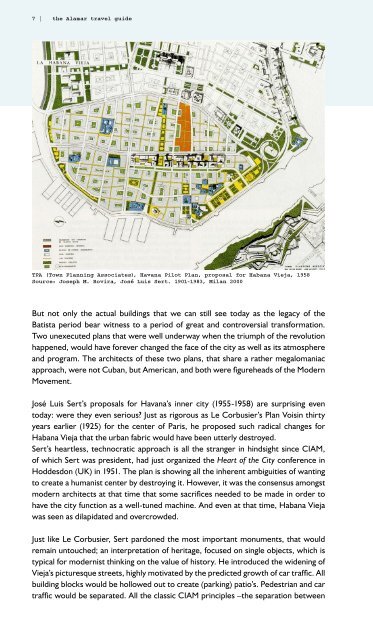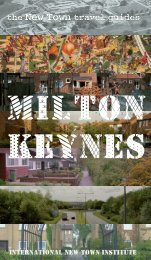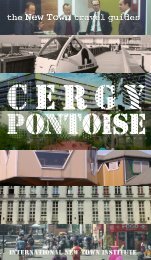You also want an ePaper? Increase the reach of your titles
YUMPU automatically turns print PDFs into web optimized ePapers that Google loves.
7 | the <strong>Alamar</strong> travel guide<br />
TPA (Town Planning Associates), Havana Pilot Plan, proposal for Habana Vieja, 1958<br />
Source: Joseph M. Rovira, José Luis Sert. 1901-1983, Milan 2000<br />
But not only the actual buildings that we can still see today as the legacy of the<br />
Batista period bear witness to a period of great and controversial transformation.<br />
Two unexecuted plans that were well underway when the triumph of the revolution<br />
happened, would have forever changed the face of the city as well as its atmosphere<br />
and program. The architects of these two plans, that share a rather megalomaniac<br />
approach, were not Cuban, but American, and both were figureheads of the Modern<br />
Movement.<br />
José Luis Sert’s proposals for Havana’s inner city (1955-1958) are surprising even<br />
today: were they even serious? Just as rigorous as Le Corbusier’s Plan Voisin thirty<br />
years earlier (1925) for the center of Paris, he proposed such radical changes for<br />
Habana Vieja that the urban fabric would have been utterly destroyed.<br />
Sert’s heartless, technocratic approach is all the stranger in hindsight since CIAM,<br />
of which Sert was president, had just organized the Heart of the City conference in<br />
Hoddesdon (UK) in 1951. The plan is showing all the inherent ambiguities of wanting<br />
to create a humanist center by destroying it. However, it was the consensus amongst<br />
modern architects at that time that some sacrifices needed to be made in order to<br />
have the city function as a well-tuned machine. And even at that time, Habana Vieja<br />
was seen as dilapidated and overcrowded.<br />
Just like Le Corbusier, Sert pardoned the most important monuments, that would<br />
remain untouched; an interpretation of heritage, focused on single objects, which is<br />
typical for modernist thinking on the value of history. He introduced the widening of<br />
Vieja’s picturesque streets, highly motivated by the predicted growth of car traffic. All<br />
building blocks would be hollowed out to create (parking) patio’s. Pedestrian and car<br />
traffic would be separated. All the classic CIAM principles –the separation between




